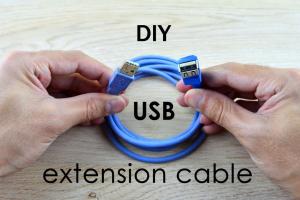Ultimate Guide on How to Extend USB Cable: Tips & Techniques

-
Quick Links:
- Introduction
- Understanding USB Cables
- Why Extend USB Cables?
- Methods to Extend USB Cables
- Case Studies
- Expert Insights
- Troubleshooting Common Issues
- FAQs
Introduction
In today's digital age, USB cables are essential for connecting devices, transferring data, and powering equipment. However, sometimes the standard length of USB cables can be limiting, especially in larger setups. This guide will provide you with various methods to extend USB cables effectively, ensuring you can maintain strong connectivity without compromising on performance.
Understanding USB Cables
USB (Universal Serial Bus) cables are used for communication and power supply between devices. They come in various types, including USB-A, USB-B, USB-C, and Micro USB. Understanding these cable types and their specifications is crucial when considering extensions.
Types of USB Cables
- USB-A: The standard rectangular connector found on most computers.
- USB-B: Typically used for printers and other larger devices.
- USB-C: A newer, reversible connector that supports faster data transfer.
- Micro USB: Commonly used for smartphones and tablets.
Why Extend USB Cables?
There are several reasons why one might need to extend a USB cable:
- Distance: Devices may be located far from the power source or computer.
- Accessibility: Making devices easier to reach for frequent use.
- Setup Flexibility: Adjusting your workstation layout or connecting devices in different locations.
Methods to Extend USB Cables
There are several methods to extend USB cables, each with its pros and cons:
1. USB Extension Cables
USB extension cables are the simplest solution. They come in various lengths and are easy to use. Just plug one end into your existing USB cable and the other into the device.
2. USB Hubs
USB hubs allow you to connect multiple USB devices to a single USB port. They can also extend the distance if they have a longer cable.
3. Active USB Extension Cables
These cables contain built-in electronics to boost the signal over longer distances. They are ideal for setups over 16 feet, where standard cables may lose connectivity.
4. Wireless USB Extenders
Wireless USB extenders use radio signals to transmit data without cables. They are suitable for environments where cabling is impractical.
5. DIY Solutions
If you're technically inclined, you can create custom USB extensions using soldering techniques or by using connectors and shielded cables. This requires a good understanding of electronics.
Case Studies
Consider the following case studies that highlight effective USB cable extension solutions:
Case Study 1: Office Setup
An office environment needed to connect multiple devices at a distance. Using active USB extension cables allowed for seamless connectivity without signal degradation.
Case Study 2: Home Theater System
A home theater system required USB connections for streaming devices. Opting for a wireless USB extender provided flexibility and reduced cable clutter.
Expert Insights
According to tech experts, using high-quality cables and connectors is essential for maintaining signal integrity. Additionally, avoiding excessive lengths with passive cables is recommended as it can lead to data loss.
Troubleshooting Common Issues
When extending USB cables, you may encounter some issues. Here’s how to troubleshoot:
- Signal Loss: Ensure you are using active cables or powered hubs for longer distances.
- Device Not Recognized: Check connections and try different ports; sometimes, a faulty port can cause the issue.
- Slow Data Transfer: Verify that the cable's specifications match the required speed of your devices.
FAQs
1. What is the maximum length for a USB cable?
The maximum length for a standard USB 2.0 cable is 16.4 feet (5 meters), while USB 3.0 cables should be kept under 9.8 feet (3 meters).
2. Can I use multiple extension cables?
Yes, but it’s advisable to limit the total length to prevent signal loss.
3. What is the difference between active and passive USB cables?
Active cables have built-in electronics that boost the signal for longer distances, while passive cables do not and are limited in length.
4. Are wireless USB extenders reliable?
Yes, but their performance can vary based on the environment and interference from other devices.
5. Can I extend a USB-C cable?
Yes, USB-C cables can also be extended using the same methods as standard USB cables.
6. Is it safe to use a DIY USB extension?
As long as proper techniques and components are used, DIY extensions can be safe, but ensure you have a good understanding of electronics.
7. What should I do if my USB device stops working after extension?
Check all connections, try a different cable, and ensure the devices are powered adequately.
8. Are there USB cables specifically for data transfer?
Yes, some cables are designed specifically for high-speed data transfer, such as USB 3.0 or 3.1 cables.
9. Can I use a USB extension cable with a printer?
Yes, as long as the extension cable is compatible with the printer's USB type.
10. How do I choose the right USB extension method?
Consider the distance, devices involved, and whether you prefer a wired or wireless solution.
Random Reads
- How to make a game pass for your game on roblox
- How to write on pictures in word
- How to write simple macro in excel
- How to build an antweight combat robot
- How to torrent games
- How to test the amperage of an outlet
- Stop ads youtube
- Simple ways to open a terminal in ubuntu
- How to check if remote control is transmitting infrared signal
- How to install chrome os flex